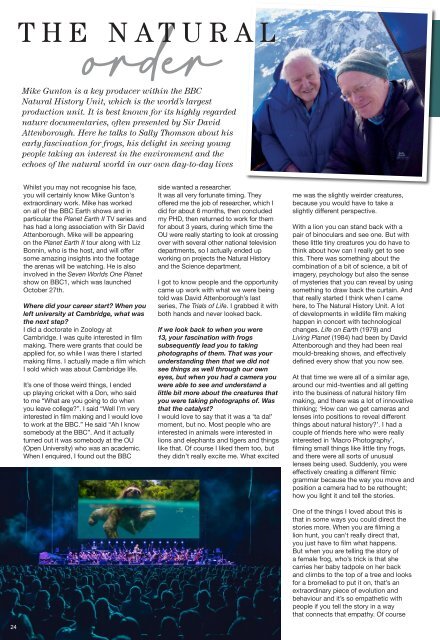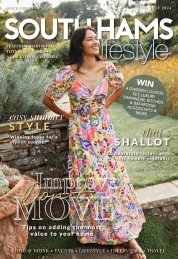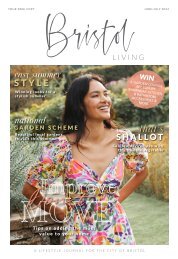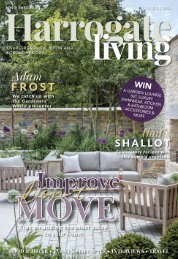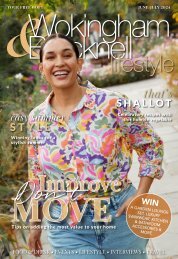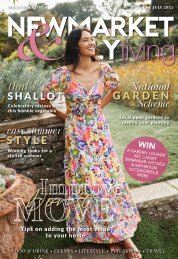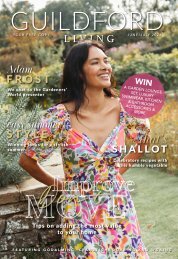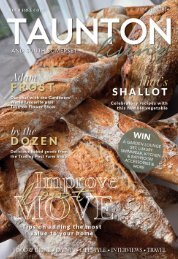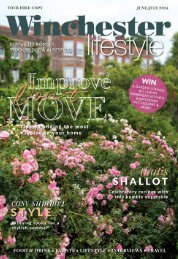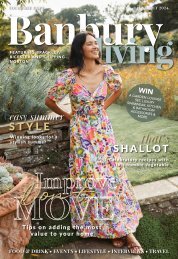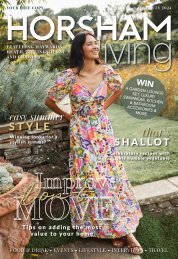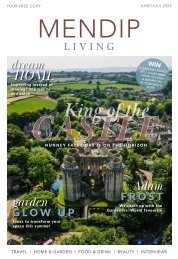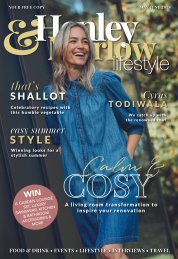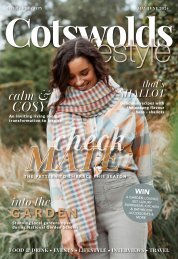Abingdon Living Jan - Feb 2020
We've got 2020 vision as we look ahead to the new year with fitness and health tips, a wedding guide, meat free recipes, an interview with chef Michael Caines and lots of home inspiration.
We've got 2020 vision as we look ahead to the new year with fitness and health tips, a wedding guide, meat free recipes, an interview with chef Michael Caines and lots of home inspiration.
You also want an ePaper? Increase the reach of your titles
YUMPU automatically turns print PDFs into web optimized ePapers that Google loves.
THE NATURAL<br />
order<br />
Mike Gunton is a key producer within the BBC<br />
Natural History Unit, which is the world’s largest<br />
production unit. It is best known for its highly regarded<br />
nature documentaries, often presented by Sir David<br />
Attenborough. Here he talks to Sally Thomson about his<br />
early fascination for frogs, his delight in seeing young<br />
people taking an interest in the environment and the<br />
echoes of the natural world in our own day-to-day lives<br />
Whilst you may not recognise his face,<br />
you will certainly know Mike Gunton's<br />
extraordinary work. Mike has worked<br />
on all of the BBC Earth shows and in<br />
particular the Planet Earth II TV series and<br />
has had a long association with Sir David<br />
Attenborough. Mike will be appearing<br />
on the Planet Earth II tour along with Liz<br />
Bonnin, who is the host, and will offer<br />
some amazing insights into the footage<br />
the arenas will be watching. He is also<br />
involved in the Seven Worlds One Planet<br />
show on BBC1, which was launched<br />
October 27th.<br />
Where did your career start? When you<br />
left university at Cambridge, what was<br />
the next step?<br />
I did a doctorate in Zoology at<br />
Cambridge. I was quite interested in film<br />
making. There were grants that could be<br />
applied for, so while I was there I started<br />
making films. I actually made a film which<br />
I sold which was about Cambridge life.<br />
It’s one of those weird things, I ended<br />
up playing cricket with a Don, who said<br />
to me “What are you going to do when<br />
you leave college?”. I said “Well I’m very<br />
interested in film making and I would love<br />
to work at the BBC.” He said “Ah I know<br />
somebody at the BBC”. And it actually<br />
turned out it was somebody at the OU<br />
(Open University) who was an academic.<br />
When I enquired, I found out the BBC<br />
side wanted a researcher.<br />
It was all very fortunate timing. They<br />
offered me the job of researcher, which I<br />
did for about 6 months, then concluded<br />
my PHD, then returned to work for them<br />
for about 3 years, during which time the<br />
OU were really starting to look at crossing<br />
over with several other national television<br />
departments, so I actually ended up<br />
working on projects the Natural History<br />
and the Science department.<br />
I got to know people and the opportunity<br />
came up work with what we were being<br />
told was David Attenborough’s last<br />
series, The Trials of Life. I grabbed it with<br />
both hands and never looked back.<br />
If we look back to when you were<br />
13, your fascination with frogs<br />
subsequently lead you to taking<br />
photographs of them. That was your<br />
understanding then that we did not<br />
see things as well through our own<br />
eyes, but when you had a camera you<br />
were able to see and understand a<br />
little bit more about the creatures that<br />
you were taking photographs of. Was<br />
that the catalyst?<br />
I would love to say that it was a ‘ta da!’<br />
moment, but no. Most people who are<br />
interested in animals were interested in<br />
lions and elephants and tigers and things<br />
like that. Of course I liked them too, but<br />
they didn’t really excite me. What excited<br />
me was the slightly weirder creatures,<br />
because you would have to take a<br />
slightly different perspective.<br />
With a lion you can stand back with a<br />
pair of binoculars and see one. But with<br />
these little tiny creatures you do have to<br />
think about how can I really get to see<br />
this. There was something about the<br />
combination of a bit of science, a bit of<br />
imagery, psychology but also the sense<br />
of mysteries that you can reveal by using<br />
something to draw back the curtain. And<br />
that really started I think when I came<br />
here, to The Natural History Unit. A lot<br />
of developments in wildlife film making<br />
happen in concert with technological<br />
changes. Life on Earth (1979) and<br />
<strong>Living</strong> Planet (1984) had been by David<br />
Attenborough and they had been real<br />
mould-breaking shows, and effectively<br />
defined every show that you now see.<br />
At that time we were all of a similar age,<br />
around our mid-twenties and all getting<br />
into the business of natural history film<br />
making, and there was a lot of innovative<br />
thinking; ‘How can we get cameras and<br />
lenses into positions to reveal different<br />
things about natural history?’. I had a<br />
couple of friends here who were really<br />
interested in ‘Macro Photography’,<br />
filming small things like little tiny frogs,<br />
and there were all sorts of unusual<br />
lenses being used. Suddenly, you were<br />
effectively creating a different filmic<br />
grammar because the way you move and<br />
position a camera had to be rethought;<br />
how you light it and tell the stories.<br />
One of the things I loved about this is<br />
that in some ways you could direct the<br />
stories more. When you are filming a<br />
lion hunt, you can’t really direct that,<br />
you just have to film what happens.<br />
But when you are telling the story of<br />
a female frog, who’s trick is that she<br />
carries her baby tadpole on her back<br />
and climbs to the top of a tree and looks<br />
for a bromeliad to put it on, that’s an<br />
extraordinary piece of evolution and<br />
behaviour and it’s so empathetic with<br />
people if you tell the story in a way<br />
that connects that empathy. Of course<br />
24


